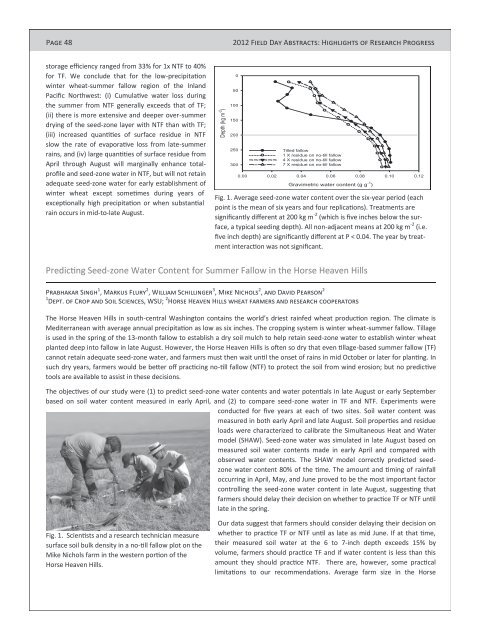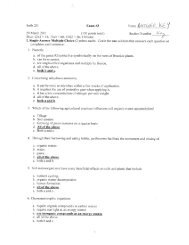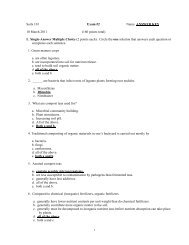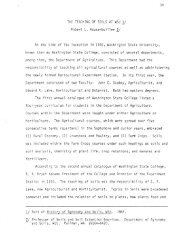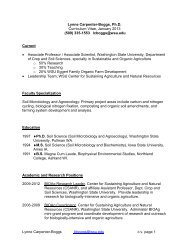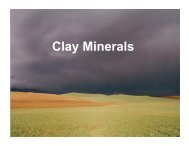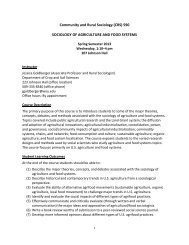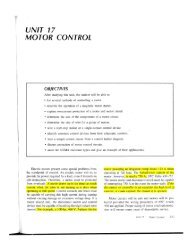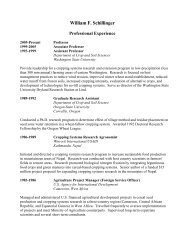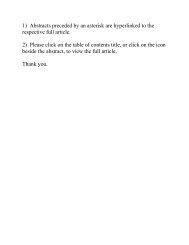2012 Dryland Field Day Abstracts - Dept. of Crop and Soil Sciences ...
2012 Dryland Field Day Abstracts - Dept. of Crop and Soil Sciences ...
2012 Dryland Field Day Abstracts - Dept. of Crop and Soil Sciences ...
You also want an ePaper? Increase the reach of your titles
YUMPU automatically turns print PDFs into web optimized ePapers that Google loves.
Page 48<br />
storage efficiency ranged from 33% for 1x NTF to 40%<br />
for TF. We conclude that for the low-precipitation<br />
winter wheat-summer fallow region <strong>of</strong> the Inl<strong>and</strong><br />
Pacific Northwest: (i) Cumulative water loss during<br />
the summer from NTF generally exceeds that <strong>of</strong> TF;<br />
(ii) there is more extensive <strong>and</strong> deeper over-summer<br />
drying <strong>of</strong> the seed-zone layer with NTF than with TF;<br />
(iii) increased quantities <strong>of</strong> surface residue in NTF<br />
slow the rate <strong>of</strong> evaporative loss from late-summer<br />
rains, <strong>and</strong> (iv) large quantities <strong>of</strong> surface residue from<br />
April through August will marginally enhance totalpr<strong>of</strong>ile<br />
<strong>and</strong> seed-zone water in NTF, but will not retain<br />
adequate seed-zone water for early establishment <strong>of</strong><br />
winter wheat except sometimes during years <strong>of</strong><br />
exceptionally high precipitation or when substantial<br />
rain occurs in mid-to-late August.<br />
<strong>2012</strong> <strong>Field</strong> <strong>Day</strong> <strong>Abstracts</strong>: Highlights <strong>of</strong> Research Progress<br />
Predicting Seed-zone Water Content for Summer Fallow in the Horse Heaven Hills<br />
Prabhakar Singh 1 , Markus Flury 2 , William Schillinger 3 , Mike Nichols 2 , <strong>and</strong> David Pearson 2<br />
1 <strong>Dept</strong>. <strong>of</strong> <strong>Crop</strong> <strong>and</strong> <strong>Soil</strong> <strong>Sciences</strong>, WSU; 2 Horse Heaven Hills wheat farmers <strong>and</strong> research cooperators<br />
The Horse Heaven Hills in south-central Washington contains the world’s driest rainfed wheat production region. The climate is<br />
Mediterranean with average annual precipitation as low as six inches. The cropping system is winter wheat-summer fallow. Tillage<br />
is used in the spring <strong>of</strong> the 13-month fallow to establish a dry soil mulch to help retain seed-zone water to establish winter wheat<br />
planted deep into fallow in late August. However, the Horse Heaven Hills is <strong>of</strong>ten so dry that even tillage-based summer fallow (TF)<br />
cannot retain adequate seed-zone water, <strong>and</strong> farmers must then wait until the onset <strong>of</strong> rains in mid October or later for planting. In<br />
such dry years, farmers would be better <strong>of</strong>f practicing no-till fallow (NTF) to protect the soil from wind erosion; but no predictive<br />
tools are available to assist in these decisions.<br />
The objectives <strong>of</strong> our study were (1) to predict seed-zone water contents <strong>and</strong> water potentials in late August or early September<br />
based on soil water content measured in early April, <strong>and</strong> (2) to compare seed-zone water in TF <strong>and</strong> NTF. Experiments were<br />
conducted for five years at each <strong>of</strong> two sites. <strong>Soil</strong> water content was<br />
measured in both early April <strong>and</strong> late August. <strong>Soil</strong> properties <strong>and</strong> residue<br />
loads were characterized to calibrate the Simultaneous Heat <strong>and</strong> Water<br />
model (SHAW). Seed-zone water was simulated in late August based on<br />
measured soil water contents made in early April <strong>and</strong> compared with<br />
observed water contents. The SHAW model correctly predicted seedzone<br />
water content 80% <strong>of</strong> the time. The amount <strong>and</strong> timing <strong>of</strong> rainfall<br />
occurring in April, May, <strong>and</strong> June proved to be the most important factor<br />
controlling the seed-zone water content in late August, suggesting that<br />
farmers should delay their decision on whether to practice TF or NTF until<br />
late in the spring.<br />
Fig. 1. Scientists <strong>and</strong> a research technician measure<br />
surface soil bulk density in a no-till fallow plot on the<br />
Mike Nichols farm in the western portion <strong>of</strong> the<br />
Horse Heaven Hills.<br />
<strong>Dept</strong>h (kg m -2 )<br />
0<br />
50<br />
100<br />
150<br />
200<br />
250<br />
300<br />
Tilled fallow<br />
1 X residue on no-till fallow<br />
4 X residue on no-till fallow<br />
7 X residue on no-till fallow<br />
0.00 0.02 0.04 0.06 0.08 0.10 0.12<br />
Gravimetric water content (g g -1 )<br />
Fig. 1. Average seed-zone water content over the six-year period (each<br />
point is the mean <strong>of</strong> six years <strong>and</strong> four replications). Treatments are<br />
significantly different at 200 kg m -2 (which is five inches below the surface,<br />
a typical seeding depth). All non-adjacent means at 200 kg m -2 (i.e.<br />
five inch depth) are significantly different at P < 0.04. The year by treatment<br />
interaction was not significant.<br />
Our data suggest that farmers should consider delaying their decision on<br />
whether to practice TF or NTF until as late as mid June. If at that time,<br />
their measured soil water at the 6 to 7-inch depth exceeds 15% by<br />
volume, farmers should practice TF <strong>and</strong> if water content is less than this<br />
amount they should practice NTF. There are, however, some practical<br />
limitations to our recommendations. Average farm size in the Horse


